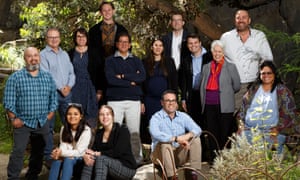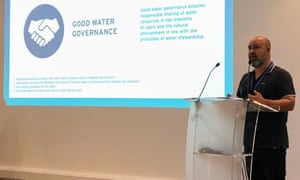Australia is often acknowledged to be the driest inhabited continent on Earth. It has been the traditional lands of Australia’s first peoples for thousands of generations. I am Kamilaroi and my cultural water (gali) place is Boobera Lagoon.
Our ancestors told stories, danced, drew in sand and dirt, painted on walls and laid down lore that was passed down for generations to tell, sing, paint and abide by. Our ancestors saw sea levels fall and rise, lived through mega-droughts and witnessed the great floods that move slowly across this flat country.
They experienced volcanic eruptions, created landscapes adapted to fire – used as cultural fire for healing and caring for country – and they maximised the sustainable use of plants and animals for survival. They followed and understood the stars to stay informed of the changing seasons. Aboriginal astronomy offers insights about country, cycles in animal breeding, migration and times to hunt – Dhinawan, the emu in the sky, is very important to my Kamilaroi mob.
In Australia we barely talk about this, let alone teach it or celebrate it. We are privileged to have access to the oldest living cultures on the planet. Cultures that have a little voice yet can tell us so much. I am tired of this, so imagine how tired my elders feel?
Protecting water places (both surface and groundwater) has always been a high priority for survival and remains a cultural obligation. Aside from coastal regions, the tropics in the wet season and the south-east riverine country, there is not much water out there – unless you know how and when to find it.
But there is growing recognition of the importance of embedding Indigenous knowledge into science. I have been given a great platform to tell my story by being awarded the CSIRO Aboriginal and Torres Strait Islander Stem professional career achievement award for 2019.

My story in water science started as dux of geology at HSC level. I changed from geology to environmental science at university when undertaking exploration for uranium on someone else’s country and in a national park proved a moral dilemma.
A master’s in hydrogeology and groundwater management allowed me to research Aboriginal peoples’ knowledge of and relationship with groundwater. Importantly, this included how the ancient water of the Great Artesian Basin recharges in north-eastern Australia and moves slowly, deep underground, for approximately 2 million years, discharging from springs in the southern basin in Kamilaroi country.
Developing teaching resources is a good strategy to amplify our voice. My master’s thesis became the basis for the Aboriginal knowledge and groundwater part of the Australian curriculum. At the University of Melbourne under Prof Marcia Langton, I led the Indigenous knowledge – water component with Michelle Hobbs and Nick Watkins.
A final resource worth mentioning is the guidance for including Indigenous cultural and spiritual values into water quality planning, together with cultural principles, by Roku Mihinui from Te Arawa Rotorua.
My career has moved from government to consulting, research, back to government and now academia. I have been lucky to travel across the globe telling my water stories and journey, raising the voice of Kamilaroi.

Beyond my PhD candidature, as always, I will do what’s best for Kamilaroi people to ensure the impact I have is culturally sound. It is the Kamilaroi methodology that honours my ancestors while challenging the status quo and encouraging future generations to pursue science.
o Bradley Moggridge is a Kamilaroi man from north-west NSW, now living on Ngunnawal country in Canberra. He is a water scientist undertaking a PhD at the University of Canberra and the Indigenous liaison officer for the TSR Hub under NESP. He is now funded by Centre of Applied Water Science UC and MDBA
o Guardian Australia is proud to partner with IndigenousX to showcase the diversity of Indigenous peoples and opinions from around the country
o Comments on this piece are premoderated to ensure discussion remains on topics raised by the writer. Please be aware there may be a short delay in comments appearing